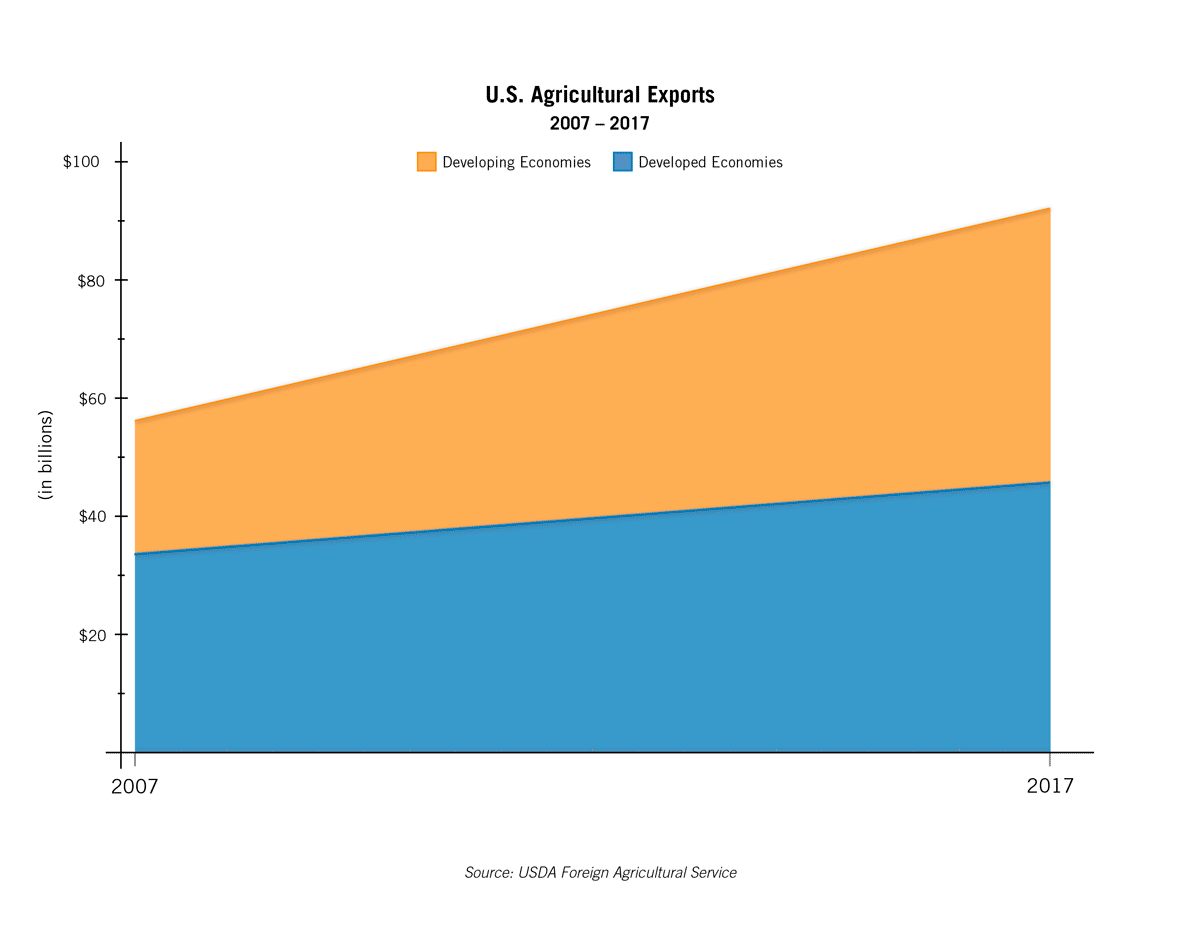
Speaking to students, farmers, and business leaders in Iowa at the beginning of the month, Secretary of State Mike Pompeo reaffirmed America’s commitment to promote global food security and prosperity in the American agricultural sector. He explained that the U.S. Agency for International Development (USAID) and the State Department “work hard to support American agriculture … so that you all can sell pork and beef, and Kansas can sell their wheat … all the things that America makes so wonderfully.”
Exports are essential to U.S. agriculture, as they help sustain America’s thriving farming, food, and related industries, which contributed $1 trillion to the U.S. economy and supported 21.6 million jobs – 11 percent of total U.S. employment – in 2017.

Developing Economies are Key for U.S. Agriculture
Accounting for more than 60 percent of U.S. agricultural exports, developing economies represent substantial market opportunities for American farmers. Between 2007 and 2017, U.S. agricultural exports to developing countries skyrocketed to $83 billion from $51 billion – a 63 percent increase – while exports to developed countries increased by 42 percent to $54 billion from $38 billion.
“In the Midwest – in the heartland America – a lot of people still depend on trade … they’re crying out for access to and more opportunities in foreign markets because that’s where so much future growth is, and opportunities lie,” said former Treasury Secretary Hank Paulson.
Paulson himself was raised on a farm in Illinois – America’s 6th largest agriculture producing state – which saw its exports to developing countries more than double from $2.4 billion to $5.2 billion between 2007 and 2017. During the same time, Ohio and Indiana saw their agricultural exports to developing countries increase by 410 percent and 250 percent, respectively.
Economic Diplomacy
Highlighting the value of economic diplomacy to U.S. global leadership and economic prosperity, Secretary Pompeo said that the State Department helps “ensure that American companies, food companies, and agriculture producers have an opportunity to sell their products, but also to help these countries grow their own domestic capabilities so that between those two they can feed all of their people.”
America has a proud legacy of leading the global fight against hunger and poverty and helping to build new markets for American farmers. Over the past 60 years, American farmers have worked hand-in-hand with the United States government to help feed more than 4 billion hungry people through USAID’s Food for Peace – a program that helped feed 70 million people across 53 countries in 2017 alone.
These programs helped transform South Korea from the economic ruins of the Korean War into the 6th largest market for U.S. agricultural products in 2017. In fact, 4 of America’s top 10 agricultural export markets today were once recipients of U.S. foreign assistance. Moreover, Feed the Future, America’s signature initiative to combat global hunger, has empowered 11 million farmers in developing countries to drive productivity growth and create new markets for American products, thereby contributing to over $1 billion additional U.S. agricultural exports to its partner countries over the past 10 years.
Investing to Lead
Despite the enormous return on investment of these programs for American farmers, the Administration’s FY2020 budget, just released this week, proposes a 24 percent cut to the International Affairs Budget. The request includes only $492 million for food security, less than half of the $1 billion appropriated by Congress in FY19. Furthermore, the Administration proposes to consolidate the four existing humanitarian assistance accounts, including Food for Peace, and to cut America’s overall humanitarian assistance funding by 34 percent as compared to FY19 enacted levels.
At a time when America’s competitors have aggressively ramped up competition with American businesses and farmers, such deep and disproportionate cuts to the International Affairs Budget would undermine America’s capacity to foster economic growth in developing countries and expand U.S. export opportunities. In under a decade, China’s agricultural investment abroad has increased more than tenfold, from $300 million in 2009 to $3.3 billion in 2016. By the end of 2016, China’s investment in foreign agriculture totaled $26 billion, with investments in over 100 countries.
Despite proposed cuts, Congress has helped ensure that America’s development and diplomacy programs have the resources necessary to be effective and advance the interests of American farmers and businesses over the past two years. As lawmakers begin to consider the President’s FY2020 Budget, they must remember that America’s development and diplomacy programs are smart, cost-effective investments that not only project American values but advance our economic interests in some of the world’s growing and competitive markets.